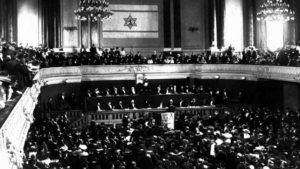
Contrary to the popular myth that “Arabs and Jews have fought for two thousand years,” the conflict in Israel/Palestine is a phenomenon of modern history. It is traceable to the rise of the Zionist movement in Europe in the late 1800’s and was exacerbated by the actions of European powers with their own agendas for this region during and immediately following World War I.
Rather than present one historical record as definitive, we provide several helpful resources for you to begin learning the history of Israel/Palestine.
GO TO, ON THIS PAGE:
• A short introductory video from JVP
• Four print resources to read online or download
Choose the length you have time for, from 6 pages to 37 pages.
• Facing the Nakba, a 7-session curriculum
• PromisedLandMuseum.org, a virtual online museum
• Understanding the Israeli-Palestinian Conflict: A Primer, by Phyllis Bennis
See also on Palestine Portal:
• A Timeline of the Israel-Palestine Conflict
• Our collection of Maps
• “Israel & Palestine: A very short introduction” (6.5 minutes) is the animated video from Jewish Voice for Peace which gives a quick look at the conflict for those new to the subject. Click the video picture to watch it.
» BACK TO TOP «
FOUR HISTORIES IN PRINT, in order of length
1. FAQ on the Nakba: The Nakba and Palestinian Refugees Today
(About 6 pages of text; read on their website.)
This short resource from Institute for Middle East Understanding (IMEU) covers some basic information about the Nakba and the Palestinians refugees, including some very interesting quotations from Israeli leaders.
2. Palestine, Israel and the Arab-Israeli Conflict, A Primer
From the Middle East Research & Information Project (MERIP)
(About 12 pages to read + photos, maps = 16 pages; Download only.)
This often recommended concise resource does an excellent job of covering the history and issues in Israel/Palestine.
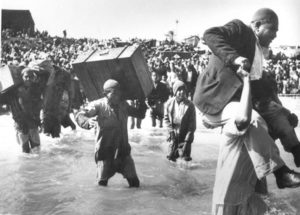
3. The Nakba: 65 Years of Dispossession and Apartheid
(About 23 pages of text; read on their website)
Another valuable resource from IMEU that deals with the history of Zionism and Israel’s creation, the catastrophe (“nakba” in Arabic) that ensued for the Palestinians, and some key issues of international law and human rights that arose at that time and in the following decades.
4. “The Origin of the Palestine-Israel Conflict”
(37 pages, Download of Word document)
An excellent history provided by Jews for Justice in the Middle East. They ask many questions that arise in studying the history of the Palestine-Israel conflict, and answer each question with brief, enlightening excerpts from books by Israeli, Palestinian, and British historians, among others.
» BACK TO TOP «
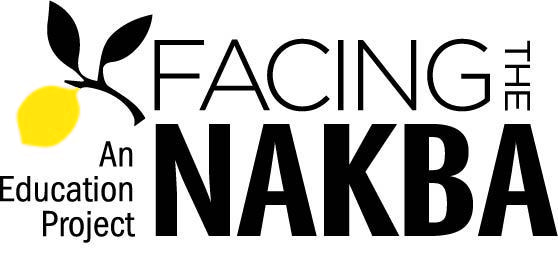 • Facing the Nakba from Jewish Voice for Peace
• Facing the Nakba from Jewish Voice for Peace
A 7-session curriculum that offers an opportunity to learn about what happened before and during 1948, to look at the ongoing effects of the Nakba, and to understand why and how that story is omitted in U.S. conversations. Find also an in-depth guide for facilitators and recommended tracks: in synagogues or on college campuses, among organizers or high school students.
» BACK TO TOP «
• PromisedLandMuseum.org: The Jewish Museum of the Palestinian Experience
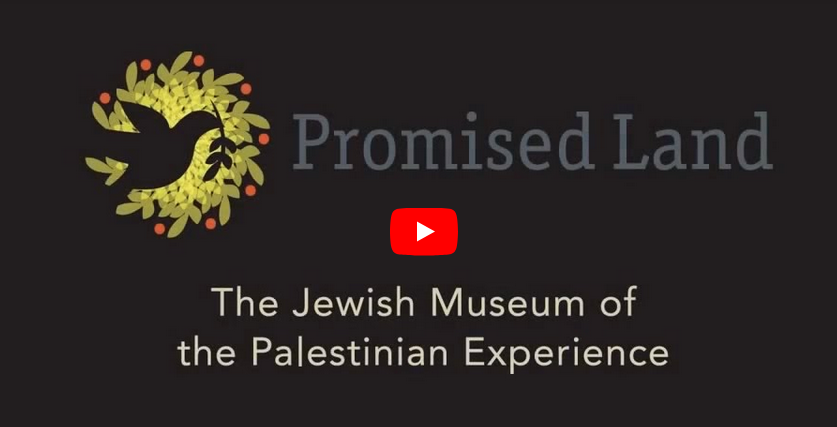 This is a digital project of the Coalition for Peace with Justice, presented in 6 easy-to-follow, engaging segments with many visual elements on a beautifully designed website. This virtual museum presents a Jewish perspective on essential Judaic values combined with information drawn largely from Jewish sources – such as JVP’s Facing the Nakba (see above on this page) – to explain the historic injustice done to the Palestinian people in the Nakba: the catastrophe for the Palestinian people of expulsion from their homeland that continues today.
This is a digital project of the Coalition for Peace with Justice, presented in 6 easy-to-follow, engaging segments with many visual elements on a beautifully designed website. This virtual museum presents a Jewish perspective on essential Judaic values combined with information drawn largely from Jewish sources – such as JVP’s Facing the Nakba (see above on this page) – to explain the historic injustice done to the Palestinian people in the Nakba: the catastrophe for the Palestinian people of expulsion from their homeland that continues today.
FOUR TIPS:
• Find the full Menu of the website by clicking the orange tab in the top left corner of the screen. (You can also use the prompts at the bottom of each page to go to the next section.)
• As you scroll down each page, click the orange tabs on the right for supplemental content in videos, photos, etc.
• Note the “Featured” Voices, Documents, etc, on the left side of the page.
• In the Menu, choose “More” for just that: great additional sources in News/Events/Resources, and the Gallery, and Get Involved.
» BACK TO TOP «
• “Understanding the Palestinian-Israel Conflict: A Primer“
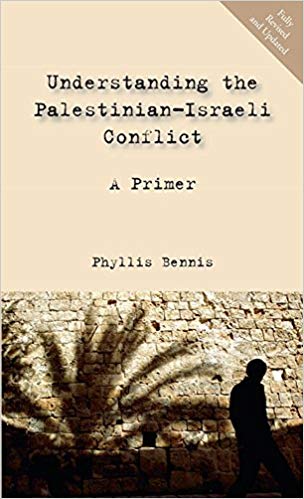 This highly recommended text provides information in small bites, with specific answers to so many of the most commonly asked questions. This easy-to-read book is an excellent resource to get a good grounding in the basic issues surrounding the conflict. Besides the print edition, inexpensive digital versions are available at Barnes and Noble and Amazon.
This highly recommended text provides information in small bites, with specific answers to so many of the most commonly asked questions. This easy-to-read book is an excellent resource to get a good grounding in the basic issues surrounding the conflict. Besides the print edition, inexpensive digital versions are available at Barnes and Noble and Amazon.
From the back cover:
If you have ever wondered “Why is there so much violence in the Middle East?,” “Who are the Palestinians?,” “What are the occupied territories?” or “What does Israel want?,” then this is the book for you.
With straightforward language, Phyllis Bennis, longtime analyst of the region, answers basic questions about Israel and Israelis, Palestine and Palestinians, the US and the Middle East, Zionism and anti-Semitism; about complex issues ranging from the Oslo peace process to the election of Hamas to the Goldstone Report and the Palestinians’ UN initiative. Together her answers provide a comprehensive understanding of the longstanding Palestinian–Israeli conflict.
Sections include: The Crisis; The Other Players: The Role of the US, the UN, the Arab States, and Europe; Recent History: Rising Violence; Looking Backward (1900-1991); The Future.
Reviews:
“Bennis (Institute for Policy Studies) utilizes a question and answer format in order to provide a well-informed and, considering its brevity, surprisingly detailed primer on Israeli-Palestinian history and politics for an American audience seeking to understand US policy in the region. All but the most expert will likely learn something and the neophyte will greatly benefit in understanding by reading this book.” – Book News
“Revised and updated in a 6th edition that addresses recent developments through early 2015, this slim handbook from Bennis…present[s] a broad overview of the history of conflict in the Holy Land, Israel’s illegal military occupation, and the moribund peace process. Bennis covers a great deal of background information in an efficient, easily digestible format; the book is divided into brief, thematically arranged question-and-answer sections that allow readers to quickly locate topics of interest.” – Publishers Weekly
About the author:
Phyllis Bennis is a fellow of the Institute for Policy Studies in Washington, and Director of its New Internationalism Program. She is also a Fellow of the Transnational Institute in Amsterdam. Her areas include U.S. unilateralism and empire, the Middle East (particularly Israel-Palestine and Iraq), and US-United Nations relations.
Bennis appears frequently as a commentator/analyst on U.S. and international television and radio programs, including The News Hour on PBS, NPR’s Diane Rehm Show, Democracy Now, the CBS Morning Show, and many others on CNN, BBC, Fox, CBC (Canada), and al-Jazeera TV.
Her work has appeared in The New York Times, The Washington Post, The Philadelphia Enquirer, the Baltimore Sun, New York Newsday, The Nation, Christian Science Monitor, Mother Jones, TomPaine.com, Middle East Report (MERIP), Le Monde Diplomatique (Paris), Papeles (Madrid), die Tageszeitung (Berlin), Soera (Amsterdam), Third World Resurgence (Malaysia), and many other publications.
Bennis is the author of Understanding ISIS and the New Global War on Terror, Challenging Empire: How People, Governments and the UN Defy US Power, Calling the Shots: How Washington Dominates Today’s UN, and Before & After: U.S. Foreign Policy and the War on Terrorism. Earlier books include From Stones to Statehood: The Palestinian Uprising, Altered States: A Reader in the New World Order, and Beyond the Storm: A Gulf Crisis Reader.



